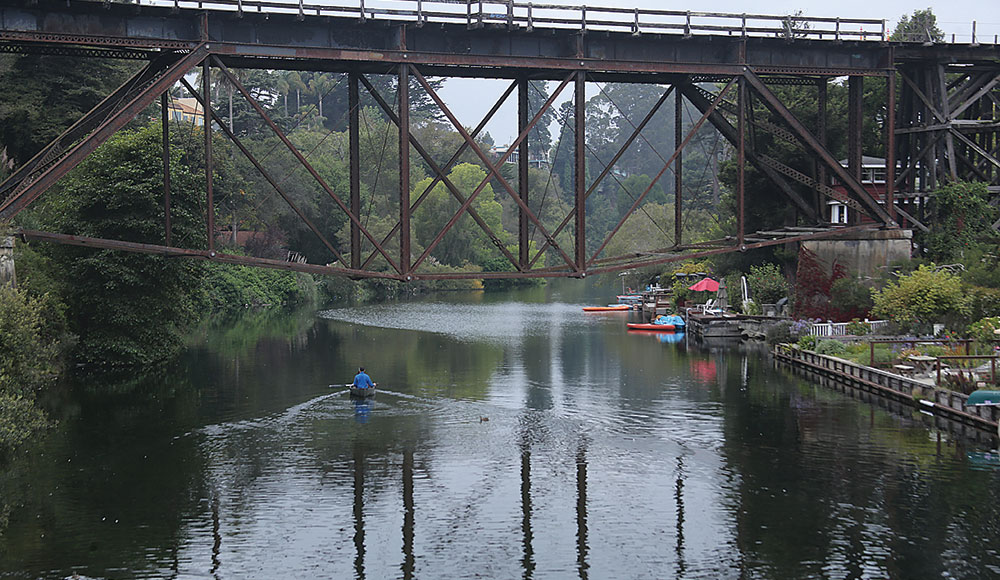The proposed 22-mile rail/trail from Watsonville to Natural Bridges will cost an estimated $4.3 billion to build and as much as $41 million a year to operate, according to a new study released by the Regional Transportation Commission—figures more than four times the estimated costs released in 2022 during the campaign in which voters approved the concept with 70 percent of the vote.
The RTC originally bought the Santa Cruz Branch Rail Line from Union Pacific in 2012 for $14.2 million.
Public meetings were held last Monday and Thursday to go over a draft report released June 6, in which it listed the costs and estimated ridership of 3,500-6,000 passenger boardings per weekday for the year 2045.
“Boardings” and “ridership” refer to the number of times a person rides the train. A single person can account for multiple boardings in one day.
The project’s new price tag is a divisive topic among community members.
“We’re in this for the long haul and we know we’re years away from the community having to make funding decisions,” said Matt Farrell, the board chair for the interest group Friends of the Rail Trail. “RTC’s work helps us understand how rail transit could work and what it will take to make it a reality.”
Farrell referred to the current progress being made on the project as “something we can all agree is great news.”
Others are more skeptical.
Bud Colligan, who works with Greenway—the local organization in support of preserving the rail and creating a trail over it—said, “The $4.3 billion is absolutely beyond the capacity of Santa Cruz County taxpayers.”
The RTC should “invest in transportation that actually moves people,” he added, suggesting Santa Cruz METRO and ParaCruz as better options.
Speakers at the Monday meeting from the RTC and the engineering companies HDR and Fehr and Peers reviewed the data presented in the Zero Emission Passenger Rail Trail or ZEPRT’s Draft Executive Summary. The summary was published Friday and details the RTC’s preliminary plans for the 22-mile rail system.
HDR is a multinational engineering firm based in Nebraska that has offices in 15 countries. Fehr and Peers is a transportation planning and engineering firm with offices across the nation. They are headquartered in Walnut Creek.
In 2023, the county secured funding to finance a study conducted by HDR, the preliminary results of which are presented in the Executive Draft Summary. It was expected that the full study would take about two years, and the Final Concept Report is planned for submission sometime this fall.
According to the summary, the RTC projects a daily ridership of 3,500-6,000 boardings per weekday for the year 2045, although they plan to open the rail line sometime before that year.
The train cars that the RTC plans to use will have a maximum capacity of 234, with room for 116 seated and 118 standing passengers.
There is no exact figure for estimating weekend ridership, but it is expected to be lower than weekdays, which is in line with the RTC’s goal for the ZEPRT to primarily be used by commuters.
The current plan is for the rail system to operate daily from 6am to 10pm, with train service every 30 minutes. The RTC estimates that it will take 40 to 45 minutes for the train to travel from the southernmost stop in Pajaro to the northernmost one at Natural Bridges Drive in Santa Cruz. HDR Project Manager Mark McLaren said the train could “operate safely” at up to 60 mph.
One of the project’s long-term goals is to connect the Santa Cruz Branch Rail Line to other rail systems in Castroville, Monterey, Gilroy and the Bay Area via the Pajaro station. An estimated 10% of riders would transfer in Pajaro, according to Fehr and Peers civil engineer Matt Haynes.
The annual cost of operation, with trains running every 30 minutes, is estimated to be up to $41 million. Alternatively, if the trains were to run every 60 minutes, the estimated annual cost could be up to $21 million.
There will be nine stations at the following locations: Pajaro, Downtown Watsonville, Aptos, New Brighton Road (intended for students of Cabrillo College), Capitola near Park Avenue, 17th Avenue, Seabright Avenue, Beach Street in Santa Cruz, and Natural Bridges Drive.
The Downtown Watsonville and Beach Street stations are expected to have the highest numbers of weekday riders, with 800-1,200 and 800-1,500 daily boardings, respectively. Capitola Station and Beach Street are projected to have the highest weekend ridership.
According to the RTC’s summary, the trains will be fully ADA compliant and will be able to accommodate multiple types of mobility devices and bicycles.
Much of the discussion at the Regional Transportation Commission Meeting on Thursday was about how the county intends to finance the project. According to McLaren, there are two possible federal grant sources: the Federal Transit Administration and the Federal Railroad Administration. McLaren said the FTA rarely gives grants above 50% of the cost, while the FRA has historically covered up to 80%. The county would apply on the condition that the ZEPRT is an inner-city rail system.
RTC officials said the cost to the county could vary from 20 to 50 percent of the total $4.3 billion and the board voted for the RTC staff to prepare a report estimating the taxpayer responsibilities for each amount.
According to RTC Executive Director Sarah Christensen, the largest grant to date that the county of Santa Cruz has received for the rail corridor was a $67 million Active Transportation Program grant in 2022.
However, there are portions of the overall cost that cannot be funded with federal or state grants, and therefore must be paid for by the community—such as the annual operating costs, which could be up to $41 million.
The county is also responsible for funding pre-construction environmental analysis, which could take about three years and would cost between $14 million and $16 million, according to McLaren.
In a response to these conditions of the project, Commissioner Kim De Serpa said, “People are tired of shouldering the burden of communities that can’t make ends meet.”
Commissioner Manu Koenig also questioned the financial feasibility of the project.
Koenig speculated that the county would have to raise its sales tax rate from where it currently sits at 9.75% to as high as 12.5% in order to be able to fund the project and the operating expenses. That increase would make Santa Cruz County’s sales tax the highest in California.
He called the expense a “crushing amount,” and said, “The pressure on our local sales tax capacity…would take all the oxygen out of the room for funding any other kind of service through sales tax pretty much ever again.”
When asked if she thought the county could realistically afford the project, Christenen said, “If we prioritize this project over other needs, and we are serious about delivering this project, our team is going to figure out how to get it done.”
De Serpa said she would not support “any effort to take money away from roads and infrastructure.”
She said that the community has other transportation-related needs, such as a lack of sheltered bus stops and roads in need of repair.

The projected expenses and ridership numbers are based on preexisting rail transit systems throughout the United States that the RTC deems comparable to the ZEPRT. Some of these systems include the eBART in the Bay Area, SPRINTER in San Diego, and the Sonoma-Marin Area Rail Transit (SMART).
However, the reliability of these comparisons is questionable.
SMART initially projected a daily ridership of 5,200 in a 2014 forecast submitted to the Federal Transit Administration. Sonoma and Marin counties have a combined population of about 736,219.
Santa Cruz County has a population of about 267,551 (according to the Santa Cruz County website), and the ZEPRT has a projected daily ridership of up to 6,000.
SMART did not meet its anticipated daily ridership rate of 5,200. In a Draft Strategic Plan for the years 2025-2030, the Sonoma-Marin Area Rail Transit District said “the SMART pathway averaged 63,610 users per month” in 2024, which is about 2,120 per day.
They also said that one of their goals for the next five years is to “increase ridership to 5,000+ per day.”
Commissioner Steve Clark expressed doubt about the accuracy of the RTC’s comparison of the ZEPRT’s ridership model to that of San Diego’s SPRINTER rail.
Clark said that the Sonoma-Marin and San Diego metro areas have a “much larger population area,” and asked, “How do we get to that ambitious conclusion that we’re going to outperform those systems?”
The original projected daily ridership for SPRINTER was 11,000 in 2012. During the fiscal year 2023- 2024, SPRINTER reported an annual total of 1,822,849 boardings, according to the San Diego Union Tribune. That’s an average of about 4,994 boardings per day.
According to McLaren, stops at each station are expected to last about 90 seconds, approximately adding an additional 10 minutes to the total trip time for anyone traveling from Pajaro to Natural Bridges Drive.
Two previously proposed station locations—at Ohlone Parkway in Watsonville and 41st Avenue in Capitola—were removed from the updated proposal. Although these are well-traversed areas, McLaren said they were withdrawn from consideration because of concerns about losing ridership over excessive travel time.
The projected total cost of $4.3 billion is broken down into different categories.
The previously calculated Conceptual Railroad Bridge Replacement and Rehab Cost of $980 million is now included in several of the cost categories listed in the Draft Executive Summary, the largest of which is titled “Contingency.”
The Contingency cost of $1.283 billion is allotted for all of the unknowns regarding construction of the rail.
The $980 million cost was calculated earlier this spring because 28 of the 33 bridges along the rail line need replacing to make the project feasible, and the remaining five need repairs. However, this amount does not account for other expenditures, such as rail construction and the implementation of signal systems.
“At this point [the contingency] is essentially the insurance policy to make sure that as the project moves forward, there aren’t risks that come forward that would significantly impact the cost of the project in a way that’s detrimental,” McLaren said.
The Final Project Concept Report will be submitted sometime this fall.














Thank you for outlining why this ill-fated train project is completely infeasible. In the history of Santa Cruz County, the RTC’s expense of tens of millions of dollars and 13 years to date on the rail project, including multiple multi-million dollar studies, will be remembered as the most unprecedented waste of public money and time ever. FORT’s long history of deliberate misinformation has done irreparable damage to actual transportation projects which could have helped the county’s population: a wide, safe multi-use continuous trail, reinvigorated METRO and ParaCruz, maintenance of deteriorating county roads, improvements to Hwy 1, and programs to get more people using realistic commute alternatives on safe pathways. We now have the opportunity to lay this project to rest once and for all with actual data commissioned by the RTC from unbiased consultants. The Commission voted for a $9 million study to determine if the project is feasible. We have our answer: it’s highly infeasible and should be terminated immediately and have staff and resources reassigned to viable projects that deliver true transit effectiveness.
It is deeply ironic that Mr. Colligan accuses FORT OF “a long history of deliberate misinformation.” That is precisely the character of Colligan’s political action group Greenway. 73% of Santa Cruz County residents who voted no on Greenway’s preposterous Measure D in 2022 districts so in reaction to the lies and misrepresentations foisted by Colligan and his gang. I have no doubt that Colligan and his co-conspirators aim is to privatize our publicly owned railroad corridor for their personal profit. Greenway’s scheme was crushed by the overwhelming will of the public three years ago. No one should have any respect for anything Colligan and his gang have to say about public transportation. They are openly enemies of the people.
The TIG/M shown was nothing like the rolling stock proposed. It was battery-electric, not hydrogen powered, it was an ultralight street car that seats like 40 people. And it didn’t go anywhere near 60 mph
The TIG/M demonstration vehicle was indeed powered by hydrogen fuel cells, which generated electricity stored in a battery bank. The byproduct was water, stored in tanks on-board. The multiple-unit rail vehicles proposed would contain a similar propulsion system, and would require no outboard power supply-meaning no overhead catenary system like the VTA light rail, and no powered third rail, like BART. Vehicles of the type proposed are in use now elsewhere, and by the time we are ready to deploy our passenger rail transportation system in 2035 or so, there will likely be improved types of rail vehicles available.
ALL INFRASTRUCTURE PROJECTS THAT CHANGE THE DYNAMIC OF TRANSPORTATION HAVE BIG COST OVERRUNS AND TAKE MUCH LONGER TO FINISH THAN ANTICPATED. we need a train running the length of the county and we need a trail that does the same. we are not a third world nation, although trumpdump is doing his worst to try to get us to that point. HE HATES TRAINS! why? the middle class uses them throughout the USA and the world. and JOE BIDEN was the best advocate of AMTRAK. trumpdump would love to end that too. i pay taxes to the county, and i am glad to pay them until this is complete. the train haters simply do not want Santa Cruz County to move into the 21st century. to them i say: get on the freeway at rush hour and breathe in deeply. that carbon monoxide and CO2 will guarantee your demise sooner. boo hoo!
The advocates of the rail have grossly underestimated the cost of the rail component. FORT’s messaging has implied that the Rail Trai project will reduce taxes, and the operating costs will be insignificant. Each successive EIR and feasibility study puts the price well beyond the projected ROI.
• The ridership projections are inflated
• In addition to the inflated ridership estimates, the study reduces the number of stations in Watsonville that would have increased ridership.
• The estimates do not include the necessary improvements to feeder lanes needed to achieve the 6,000/day ridership.
• An every 30-minute schedule would cost $41 million a year with nine stops, an every hour schedule would make it useless as a commuting option, and still cost $21 million/year.
• This estimate excludes the operating costs of the section to Davenport and beyond, which is already under construction.
• The Estimate is up 4x the estimate in 2022
• The study acknowledges that over 25% of the estimate is for unknown costs
• This is not scheduled for completion until 2045! Twenty years of inflation and cost overruns
We could have a network of paths similar to Monterey County in a decade at 1/4 the cost and enjoy the economic benefits for a decade before any rail-based option reaches Watsonville.
How can you be so willfully ignorant? You know nothing about methodology for projecting ridership 20 years in the future.FORT has never said or implied that the rail and trail project will reduce taxes, or that the O&M costs will be insignificant. According to the HDR projection, they will certainly be less than Metro’s O&M costs, though. It’s abysmally stupid to speak of “ROI” in a public works project. The concept or “return on investment “ simply doesn’t apply in the public sector. Picking at details like the number of stations and “feeder lanes,” whatever that means, is laughable. There is no rail service planned to Davenport. It’s Watsonville to Santa Cruz. There was no RTC estimate made in 2022. That’s a bogus claim. The “unknown costs” part of the HDR’s extreme worst case scenario estimate is an artificial contingency factor, standard practice in estimating costs of major transportation projects at the early conceptual stage – it’s not a realistic cost factor. All engineering details are as yet unknown, and major design decisions are yet to be made. There is no schedule for completion, and no budget yet proposed. The project is still in a very preliminary concept design stage. The RTC principal planner for RTC told me he thinks the project could be completed 15 years from now. The 2045 date for the O&M cost estimates assumes that the project will have been in operation for at least 5 years by that time, and ridership patterns will have been stabilized. Your comments are non-serious, and are merely spurious objections meant to bolster your pre-conceived opposition to public transportation.